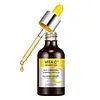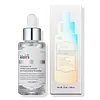What's inside
What's inside
 Key Ingredients
Key Ingredients

 Benefits
Benefits

 Concerns
Concerns

 Ingredients Side-by-side
Ingredients Side-by-side

Glycyrrhiza Uralensis Root Extract
Skin ConditioningHippophae Rhamnoides Water
MaskingGlycerin
HumectantMethylpropanediol
SolventButylene Glycol
HumectantNiacinamide
SmoothingDiethoxyethyl Succinate
Solvent1,2-Hexanediol
Skin ConditioningTocopheryl Acetate
AntioxidantWater
Skin Conditioning3-O-Ethyl Ascorbic Acid
Skin ConditioningBifida Ferment Lysate
Skin ConditioningTranexamic Acid
AstringentSodium Polyacryloyldimethyl Taurate
Emulsion StabilisingChlorella Vulgaris Extract
Skin ConditioningGlucose
HumectantCaprylic/Capric Triglyceride
MaskingGlycine Soja Oil
EmollientFructooligosaccharides
HumectantFructose
HumectantArbutin
AntioxidantHydrogenated Lecithin
EmulsifyingPanthenol
Skin ConditioningCitrus Aurantium Dulcis Peel Oil
MaskingXanthan Gum
EmulsifyingAdenosine
Skin ConditioningEthylhexylglycerin
Skin ConditioningCitric Acid
BufferingPolyquaternium-51
Skin ConditioningCeramide NP
Skin ConditioningCitrus Grandis Peel Oil
MaskingSodium Phytate
Eucalyptus Globulus Leaf Oil
PerfumingLavandula Angustifolia Oil
MaskingSodium Citrate
BufferingDaucus Carota Sativa Root Extract
Skin ConditioningBeta-Carotene
Skin ConditioningTocopherol
AntioxidantHydrolyzed Collagen
EmollientAllantoin
Skin ConditioningGlyceryl Glucoside
HumectantDipropylene Glycol
HumectantPalmitoyl Tripeptide-5
Skin ConditioningCaprylyl Glycol
EmollientAscorbic Acid
AntioxidantHyaluronic Acid
HumectantAcetyl Hexapeptide-8
HumectantPentylene Glycol
Skin ConditioningPvp
Emulsion StabilisingLaurdimonium Hydroxypropyl Hydrolyzed Wheat Protein
Hydrolyzed Hyaluronic Acid
HumectantSodium Hyaluronate
HumectantPhytosterols
Skin ConditioningAscorbyl Glucoside
AntioxidantFullerenes
AntimicrobialLimonene
PerfumingLinalool
PerfumingGlycyrrhiza Uralensis Root Extract, Hippophae Rhamnoides Water, Glycerin, Methylpropanediol, Butylene Glycol, Niacinamide, Diethoxyethyl Succinate, 1,2-Hexanediol, Tocopheryl Acetate, Water, 3-O-Ethyl Ascorbic Acid, Bifida Ferment Lysate, Tranexamic Acid, Sodium Polyacryloyldimethyl Taurate, Chlorella Vulgaris Extract, Glucose, Caprylic/Capric Triglyceride, Glycine Soja Oil, Fructooligosaccharides, Fructose, Arbutin, Hydrogenated Lecithin, Panthenol, Citrus Aurantium Dulcis Peel Oil, Xanthan Gum, Adenosine, Ethylhexylglycerin, Citric Acid, Polyquaternium-51, Ceramide NP, Citrus Grandis Peel Oil, Sodium Phytate, Eucalyptus Globulus Leaf Oil, Lavandula Angustifolia Oil, Sodium Citrate, Daucus Carota Sativa Root Extract, Beta-Carotene, Tocopherol, Hydrolyzed Collagen, Allantoin, Glyceryl Glucoside, Dipropylene Glycol, Palmitoyl Tripeptide-5, Caprylyl Glycol, Ascorbic Acid, Hyaluronic Acid, Acetyl Hexapeptide-8, Pentylene Glycol, Pvp, Laurdimonium Hydroxypropyl Hydrolyzed Wheat Protein, Hydrolyzed Hyaluronic Acid, Sodium Hyaluronate, Phytosterols, Ascorbyl Glucoside, Fullerenes, Limonene, Linalool
Water
Skin ConditioningPropylene Glycol
HumectantAscorbic Acid
AntioxidantHydroxyethylcellulose
Emulsion StabilisingCitrus Junos Fruit Extract
Skin ConditioningCentella Asiatica Extract
CleansingPolysorbate 60
EmulsifyingIllicium Verum Fruit Extract
PerfumingChaenomeles Sinensis Fruit Extract
AntioxidantPaeonia Suffruticosa Root Extract
Skin ProtectingBrassica Oleracea Italica Extract
AstringentNelumbium Speciosum Flower Extract
Skin ConditioningCitrus Paradisi Fruit Extract
Skin ConditioningScutellaria Baicalensis Root Extract
AstringentButylene Glycol
HumectantGlycerin
HumectantCitrus Aurantium Dulcis Oil
Masking1,2-Hexanediol
Skin ConditioningSodium Acrylate/Sodium Acryloyldimethyl Taurate Copolymer
Emulsion StabilisingIsohexadecane
EmollientDisodium EDTA
Lavandula Angustifolia Oil
MaskingCamellia Sinensis Callus Culture Extract
PerfumingPolysorbate 80
EmulsifyingDisodium Phosphate
BufferingSorbitan Oleate
EmulsifyingChrysanthellum Indicum Extract
Skin ConditioningAsarum Sieboldii Root Extract
Skin ConditioningQuercus Mongolica Leaf Extract
Skin ConditioningPersicaria Hydropiper Extract
Skin ConditioningLarix Europaea Wood Extract
HumectantMagnolia Obovata Bark Extract
Skin ConditioningRheum Palmatum Root Extract
AstringentCorydalis Turtschaninovii Root Extract
Skin ConditioningCoptis Chinensis Root Extract
AntioxidantSodium Phosphate
BufferingLysine Hcl
Skin ConditioningSodium Ascorbyl Phosphate
AntioxidantAcetyl Methionine
Skin ConditioningTheanine
EmollientProline
Skin ConditioningLecithin
EmollientAcetyl Glutamine
Skin ConditioningBacillus/Folic Acid/Soybean Ferment Extract
Skin ConditioningSodium Hyaluronate
HumectantSh-Oligopeptide-1
Skin ConditioningSh-Oligopeptide-2
Skin ConditioningSh-Polypeptide-1
Skin ConditioningSh-Polypeptide-11
Sh-Polypeptide-9
Skin ConditioningCaprylyl Glycol
EmollientLimonene
PerfumingWater, Propylene Glycol, Ascorbic Acid, Hydroxyethylcellulose, Citrus Junos Fruit Extract, Centella Asiatica Extract, Polysorbate 60, Illicium Verum Fruit Extract, Chaenomeles Sinensis Fruit Extract, Paeonia Suffruticosa Root Extract, Brassica Oleracea Italica Extract, Nelumbium Speciosum Flower Extract, Citrus Paradisi Fruit Extract, Scutellaria Baicalensis Root Extract, Butylene Glycol, Glycerin, Citrus Aurantium Dulcis Oil, 1,2-Hexanediol, Sodium Acrylate/Sodium Acryloyldimethyl Taurate Copolymer, Isohexadecane, Disodium EDTA, Lavandula Angustifolia Oil, Camellia Sinensis Callus Culture Extract, Polysorbate 80, Disodium Phosphate, Sorbitan Oleate, Chrysanthellum Indicum Extract, Asarum Sieboldii Root Extract, Quercus Mongolica Leaf Extract, Persicaria Hydropiper Extract, Larix Europaea Wood Extract, Magnolia Obovata Bark Extract, Rheum Palmatum Root Extract, Corydalis Turtschaninovii Root Extract, Coptis Chinensis Root Extract, Sodium Phosphate, Lysine Hcl, Sodium Ascorbyl Phosphate, Acetyl Methionine, Theanine, Proline, Lecithin, Acetyl Glutamine, Bacillus/Folic Acid/Soybean Ferment Extract, Sodium Hyaluronate, Sh-Oligopeptide-1, Sh-Oligopeptide-2, Sh-Polypeptide-1, Sh-Polypeptide-11, Sh-Polypeptide-9, Caprylyl Glycol, Limonene
 Reviews
Reviews

Ingredients Explained
These ingredients are found in both products.
Ingredients higher up in an ingredient list are typically present in a larger amount.
1,2-Hexanediol is a synthetic liquid and another multi-functional powerhouse.
It is a:
- Humectant, drawing moisture into the skin
- Emollient, helping to soften skin
- Solvent, dispersing and stabilizing formulas
- Preservative booster, enhancing the antimicrobial activity of other preservatives
Ascorbic Acid is is pure Vitamin C. This form makes up the largest amount of vitamin C found naturally in our skin.
Not only is vitamin C great for your overall health and immune system, it also has plenty of benefits on your skin.
Vitamin C is best used for brightening skin. It improves dark spots, acne scars, and hyperpigmentation. This is because it blocks the process of skin darkening when exposed to UV.
Remember: Vitamin C should not replace sunscreen!
Your skin uses vitamin C to build collagen. Collagen is one key component in having a strong skin barrier and plump skin. Vitamin C also plays a role in regulating collagen, thus making it effective in improving wrinkles and fine lines.
Ascorbic acid shows potent antioxidant activity. As an antioxidant, it helps fight free-radicals. Free-radicals are molecules that may damage your skin cells. These antioxidants also protect skin against UV damage.
The best formulations include Vitamin E and/or ferulic acid. These two ingredients help stabilize and provide a boost in the benefits of ascorbic acid. This is because ascorbic acid becomes unstable when exposed to UV and air. In fact, you can tell your ascorbic acid has oxidized when it turns an orange-yellow color.
Ascorbic acid is generally compatible with other ingredients. However, using ascorbic acid with other active ingredients might cause irritation. Two ingredients: copper ions and benzoyl peroxide, will inactivate ascorbic acid completely.
Read more about other types of Vitamin C:
Foods rich with vitamin C include oranges, strawberries, broccoli, bell peppers, and more. When consuming Vitamin C, your skin receives a portion of the nutrients.
Learn more about Ascorbic AcidButylene Glycol (or BG) is used within cosmetic products for a few different reasons:
Overall, Butylene Glycol is a safe and well-rounded ingredient that works well with other ingredients.
Though this ingredient works well with most skin types, some people with sensitive skin may experience a reaction such as allergic rashes, closed comedones, or itchiness.
Learn more about Butylene GlycolCaprylyl Glycol is a humectant and emollient, meaning it attracts and preserves moisture.
It is a common ingredient in many products, especially those designed to hydrate skin. The primary benefits are retaining moisture, skin softening, and promoting a healthy skin barrier.
Though Caprylyl Glycol is an alcohol derived from fatty acids, it is not the kind that can dry out skin.
This ingredient is also used as a preservative to extend the life of products. It has slight antimicrobial properties.
Learn more about Caprylyl GlycolGlycerin is already naturally found in your skin. It helps moisturize and protect your skin.
A study from 2016 found glycerin to be more effective as a humectant than AHAs and hyaluronic acid.
As a humectant, it helps the skin stay hydrated by pulling moisture to your skin. The low molecular weight of glycerin allows it to pull moisture into the deeper layers of your skin.
Hydrated skin improves your skin barrier; Your skin barrier helps protect against irritants and bacteria.
Glycerin has also been found to have antimicrobial and antiviral properties. Due to these properties, glycerin is often used in wound and burn treatments.
In cosmetics, glycerin is usually derived from plants such as soybean or palm. However, it can also be sourced from animals, such as tallow or animal fat.
This ingredient is organic, colorless, odorless, and non-toxic.
Glycerin is the name for this ingredient in American English. British English uses Glycerol/Glycerine.
Learn more about GlycerinLavandula Angustifolia Oil is more commonly known as lavender essential oil. It is considered a fragrancing ingredient.
Lavender imparts a famous scent. While the smell is lovely, this ingredient and may sensitize skin in topical products. This is because about 85% of the oil is made up of linalool and linalyl acetate.
When exposed to air, these two compounds become strong allergens. This ingredient exhibits cytotoxicity at low concentrations; amounts of 0.25% have been shown to damage skin cells.
A study from Japan found this ingredient caused lavender sensitivity after widespread exposure.
Lavender essential oil has some antimicrobial, antibacterial, and anti-inflammatory properties. However, the cons of this ingredient may outweight the pros.
More research is needed to confirm lavender essential oil's effects when used in aromatherapy.
Lavandula Angustifolia is known as the English Lavender and famous for creating purple fields in Provence, France.
Learn more about Lavandula Angustifolia OilLimonene is a fragrance that adds scent and taste to a formulation.
It's found in the peel oil of citrus fruits and other plants such as lavender and eucalyptus. The scent of limonene is generally described as "sweet citrus".
Limonene acts as an antioxidant, meaning it helps neutralize free radicals.
When exposed to air, oxidized limonene may sensitize the skin. Because of this, limonene is often avoided by people with sensitive skin.
The term 'fragrance' is not regulated in many countries. In many cases, it is up to the brand to define this term. For instance, many brands choose to label themselves as "fragrance-free" because they are not using synthetic fragrances. However, their products may still contain ingredients such as essential oils that are considered a fragrance.
Learn more about LimoneneSodium Hyaluronate is hyaluronic acid's salt form. It is commonly derived from the sodium salt of hyaluronic acid.
Like hyaluronic acid, it is great at holding water and acts as a humectant. This makes it a great skin hydrating ingredient.
Sodium Hyaluronate is naturally occurring in our bodies and is mostly found in eye fluid and joints.
These are some other common types of Hyaluronic Acid:
Learn more about Sodium HyaluronateWater. It's the most common cosmetic ingredient of all. You'll usually see it at the top of ingredient lists, meaning that it makes up the largest part of the product.
So why is it so popular? Water most often acts as a solvent - this means that it helps dissolve other ingredients into the formulation.
You'll also recognize water as that liquid we all need to stay alive. If you see this, drink a glass of water. Stay hydrated!
Learn more about Water